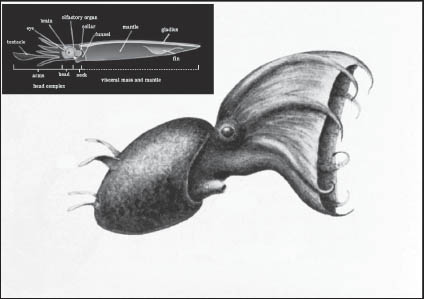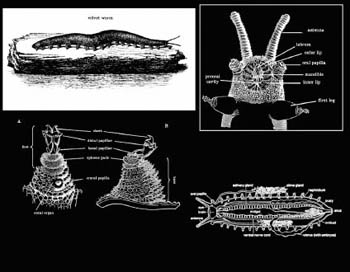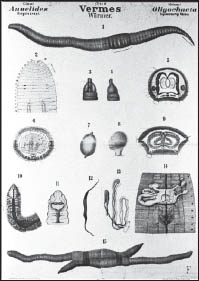VAMPIRE SQUID
Tentacled Terror

Living in the dark ocean depths, this small 1-foot-long squid has a web of skin that connects its eight tentacles together, causing it to look like a sinister creature with a black cape. Its big red eyes make it seem even more horrific. However, the vampire squid is no more bloodthirsty than any of its other larger squid relations, even if its joined tentacles give it a swooping and whirling motion as it swims.
Since it swims slowly with its permanently attached Dracula cape, the vampire squid makes up for this disadvantage by having an extremely strong clamping beak. The squid is hard to detect in the dark ocean, where it lives in depths of 3,000 feet, and because of its black color it does not need to chase after and track down prey. Once a small fish is seized in its vampiric grip, there is no escape. It uses its webbed tentacles like a net. This squid does not eat that often, having a very slow metabolism that helps it survive the cold water depths.
No one knew vampire squid existed until 1903 when one was first dragged up in a fisherman’s net, and it is still uncertain whether they live in underwater sea caves or roam freely in the open ocean. When first encountered, people thought the creature escaped out of a portal from hell. However, when it was learned that these squid change colors, transforming from black to bright red or blue, twinkling like a Christmas ornament, their sinister reputation changed, if not their name. They have bioluminous lights, called “photophores,” emitting from their skin, which flash in synchronized patterns to attract mates and for navigation. Fossils reveal the vampire squid has remained unchanged for more than three hundred million years, though how long it lives and how it dies remain mysteries.
Instead of ink that some squid disperse to conceal themselves, the vampire squid discharges a cloud of gooey mucus that chokes up visibility, blinding its pursuers in a mess of phlegm.
VELVET WORM
Slow Slimer

Appearing as a cross between a worm and a caterpillar, the velvet worm is actually not related to either but rather is more closely linked to scorpions and primitive crabs. It grows to about 7 inches, has tiny pinhead-sized eyes, two flat and thin antennae, and it is soft bodied. The velvet worm moves slowly and sluggishly on about forty-two pairs of legs. It lives mostly in equatorial regions of the Southern Hemisphere, with other types found in parts of Africa, Asia, and Australia. It usually prefers being on the ground in tropical forests or under leaves where it hunts for smaller insects, which it captures by smothering the creatures with a gluelike slime the worm spits out.
If the velvet worm seeks larger prey, the slime will tie up the bigger insect’s limbs, rendering its victim immobile. The velvet worm has large lips it uses to suck at its sticky-trapped catch and then chews it with jaws or small mandibles deep in its throat. Its muscles to move its teeth back and forth to shred and grind up its food.
Slime World
Males transfer their seed by carrying sperm on their antennae, and when a female is encountered, a male inserts its entire head into her abdomen. Instead of starting life as eggs, young velvet worms are born alive. They are communal beasts, and the juveniles are not eaten by the parents, but rather are allowed to hitch rides on the females’ backs.
By some unknown means of communication, velvet worms hunt cooperatively. Sometimes they appear to gather under a rotting log as if in a planning stage and then split up into assault teams to begin a foraging campaign, even if in a slow-motion fashion. Size is what determines the status among velvet worms, and when meeting, they measure the newcomer by tracing their antennae along the other worm’s entire length. When hunting together, the dominant (i.e., biggest) female usually gets the first bite. The velvet worm can live for up to six years.
The velvet worm’s slime is shot from two portals below its antennae. Composed of proteins, the gooey substance forms a net, engulfing a small insect as if it were caught in a minipatch of quicksand.
—
Although the brain of this creature is minuscule, the worm displays social behavior more akin to that of certain mammals.
Worms Among Us
The word worm is generally used to describe any cylinder-shaped and wiggling, soft-bodied invertebrate. The earthworm is the most commonly recognized and abundant of the true worms, or annelids. The earthworm is literally a tube of muscular meat, with a brain and five hearts that pump its blood along a rudimentary circulatory system. All earthworms have both male and female organs, but they need a partner to play an opposing role in order to reproduce. However, if a worm is cut into parts, with the exception of its head, it can rejuvenate a segment. Worms have eyes, but only for sensing light or darkness. Instead, they can sense stimuli throughout their entire bodies. They breathe through their skin and need moisture to process the oxygen; a dried-out worm actually suffocates. They eat bacterium and decaying leaves, thus functioning as superior aerators of soil. Many animals, fish, birds, and amphibians have them on their most delicious lists, and worms are frequently devoured—one reason why they have a short life span. However, despite its defenselessness, a fortunate worm can live for six years.

